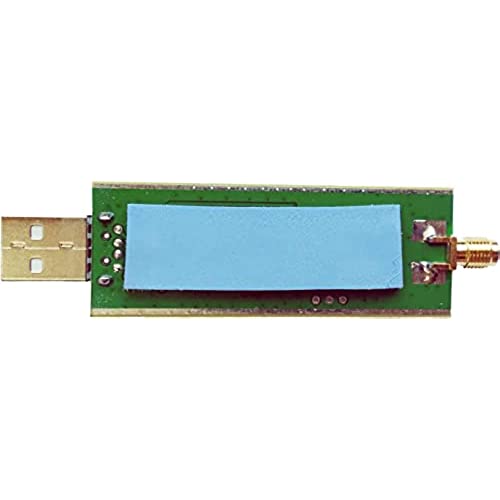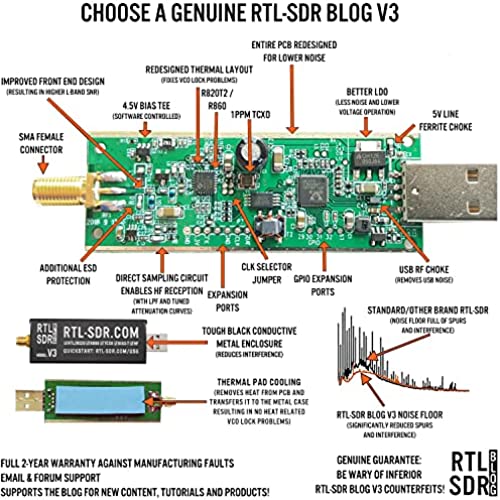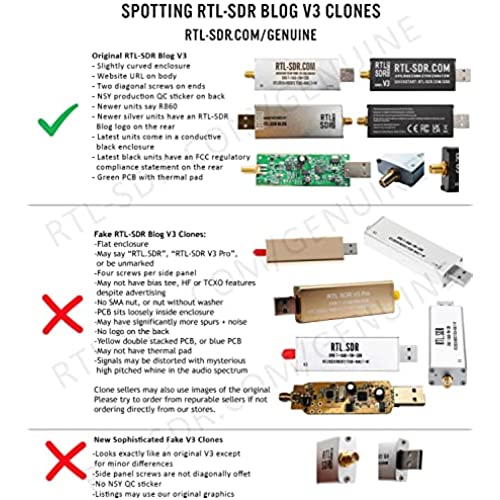













RTL-SDR Blog V3 R860 RTL2832U 1PPM TCXO SMA Software Defined Radio (Dongle Only) (Black)
-

Sean Wilson
> 3 dayThe rtl-sdr blog made device beats the clones. Idk what else to say.
-

Joe
> 3 dayHave bought other SDR and DVB/DAB dongles and so far this is the best one. Gets hot with use. Would like to have better contact with a heat sink or some holes to circulate air in the dongle to keep it cooler. Very accurate ppm, worst dongle I have is -2.2 ppm off frequency. Definitely worth the buy if you want to use this at home as a hobby or need to get into the scene at a reasonable price.
-

David R.
> 3 dayThis is a very sensitive and versatile receiver. Works great on both my Linux and Windows laptop computers. I also have it running on a Raspberry Pi mini computer. Does voice and data, analog and digital. I suggest outdoor antennas and good grounding for optimal performance. Highly recommended.
-

RonL
Greater than one weekHere it is attached to my Raspberry Pi acting as an ADS-B station. The design of the CPU allows the device to hang in mid-air letting it stay cool running 24x7. According to the stats pages, it is doing exactly what it is supposed to.
-

LSDean
> 3 dayAs far as I can tell it works well for a $21 SDR when used alone, but I purchased it to be a panadapter for my TS-590SG and right now, they dont play well together. Construction is solid but this is not a Plug and Play dongle by any means and youre going to need to download 3 programs beyond an SDR interface (SDR#, HDSDR et al) just to install the drivers needed to get it to function on a Windows machine (I wont even bother with the software headaches to attempt to turn it into a panadapter for a Kenwood). It also emits a heck of a lot of RFI. I had it sitting next to my Kenwood that I was listening to an AM signal on 3.750 MHz when I powered up the RTL-SDR and the S7 station I was listening was suddenly drowned in static at 20 over S9. Moving the RTL-SDR 3 feet away from my radio cleared the problem. Pros: Price and physical durability. Cons: Not for an SDR Novice due to software needs and set-up, not well shielded and produces RFI that will interfere with a HF radio. Buy it if you know what youre doing with an SDR and not planning on doing any Ham operations in the same room.
-

Audiophile Headcase
> 3 dayDont believe the hype from some posters. Not any better than the NooElec version of the RTLSDR which also has TCXO for tighter frequency stability. My RTL-SDR.com USB stick arrived with a very lose SMA antenna connection which needed to be tightened. Otherwise, the construction seems to be OK. I prefer the NooElec version of the RTLSDR USB receiver because it comes in a much larger aluminum container to better dissipate generated heat. This RTLSDR USB stick wouldnt work for me in the SDRSharp app even using the Zadig.exe app to modify the USB drivers. Constantly got No Device Selected in SDSharp (V.1.0.0.1464). Fix was to download special libs ( RelWithDebInfo.zip ) at the Osmocom site and then replace the original files in the SDRSharp folder with the Osmocom versions of the files. After that it worked fine in SDRSharp. This unit is listed as covering shortwave (i.e., below 25 MHz) but you have to use the method of Direct Sampling of the Q branch for this and the performance on HF when using this trick is dismal. It works but just barely. HF signals were noisy and weak. It is apparent that there is little to no front-end pre-filtering on this device. Got lots of FM station blow by coming through on many frequencies in HF/VHF/UHF. Had to turn the RF gain way down to constrain this problem and I dont live in a particularly strong RF environment near any powerful AM/FM stations. Also, there were internally generated spurs and birdies all over the place. I have seen these types of issues in many of the cheap $20 RTLSDR USB sticks. If you are serious about using one of these RTLSDR units for HF listening you really need to see about acquiring an up-converter like NooElecs Ham It Up or Airspys Spyverter. Even then, you would be well advised to use some type of RF preamplifier/preselector ahead of the HF up-converter to improve sensitivity and to help squash the unwanted images that are caused by nearby AM/FM stations and other strong local RF sources like pagers. Most people would be far better served with something like the SDR Play receiver for their entry into the world of software defined radios. It is less than $150 and doesnt have the issues that plague these cheap $20 RTLSDR DAB-TV tuners. I own many different SDRs including the SDR Play, the AirSpy with SpyVerter (HF) and a high-end RFSpace NetSDR+ and have found the SDR Play (sdrplay.com) to be an extremely good bang for the buck. It has reasonable pre-filtering and the setup is easier than dealing with the software conflicts that seem to arise with these cheap $20 RTLSDR dongles. Once you have experienced using a properly designed SDR youll likely never go back to using one of these striped down, cheap RTLSDR units. Yes, they are dirt cheap but they come with some serious drawbacks. If you try to mitigate the drawbacks of these cheap USB sticks with add-ons like preselectors/preamplifiers, HF up-converters, attenuators, etc you quickly find that you have spent about the same amount of money that could have been used to buy a properly designed SDR like the SDR Play.
-

Ben
> 3 dayReally, the cheapest and easiest way to get into Software Defined Radio. With this dongle, SDRSharp (SDR#) and a decent antenna, youve opened up a massive portion of the RF spectrum to listen to. From broadcast band and aircraft monitoring, to public safety agencies (if theyre analog). One of these dongles, SDR# and Uni-Trunker is a great way to map out unknown trunking radio systems as well. I believe you can also get a converter for these dongles that will allow you to listen down into shortwave territory. The dongle seems to be of quality construction, no worrys about having to baby it. One thing Ive noted as others have, it gets pretty hot after running for a couple hours. Heat is the enemy of all solid state electronics, so well what all that heat means for long term durability. But Ive had this running for 9 hours a day since I got it about 2-3 weeks ago and no hiccups so far.
-

J2021g
Greater than one weekInteresting technology. Downloading SDR software was easy but the sequence of activating three different files to get the SDR receiver on line was daunting. Once active then it is a single file (SDR#) boot. A fast computer is needed to get the best performance of the display. At first I was unable to get HF reception until I stopped the play by hitting the square icon then going to the settings gear and selecting DIRECT SAMPLING Q Branch. Then HF came alive. Yay. Maybe not as sensitive as I would like but it works. Noise floor at 100 MHz seems higher than normal but that could just be my setup. Now it is neat to tune all around the spectrum and see what gives. Looks like the Hartley Super hetrodyne technology of the 1920s is about to give way to A/D conversion!
-

John F.
> 3 dayThe RTL SDR and the NOelec are the best two SDR dongles for the money. The RTL SDR dongle is my personal favorite, it brings in weak signals.
-

BTC
> 3 dayThis takes a little work to use but compared to a regular scanner you cant beat the price for the range it picks up. Yes its got some issues, but nothing comes close to being able to do what this does for the price. So far Ive listened to PD, NOAA, FM broadcast (music statioins), CB, airband, decoded pagers, WWV, HAM, and more. This is not for the novice but there are plenty of YouTube videos on what you can do and how to do it for this receiver. This would be an excellent gift for a teenager interested in radio (and yes itll receive image data too, like wether maps directly from satellites). A good computer is required to use it. Software exists for both Windows and Mac systems.

